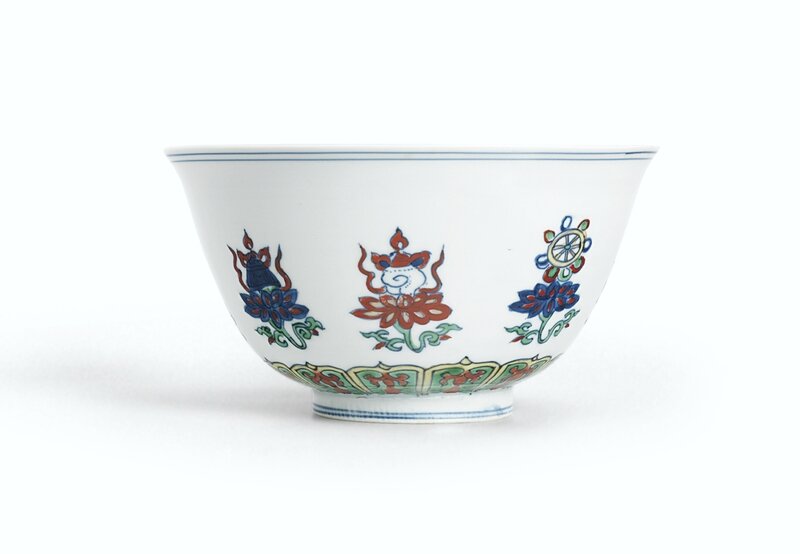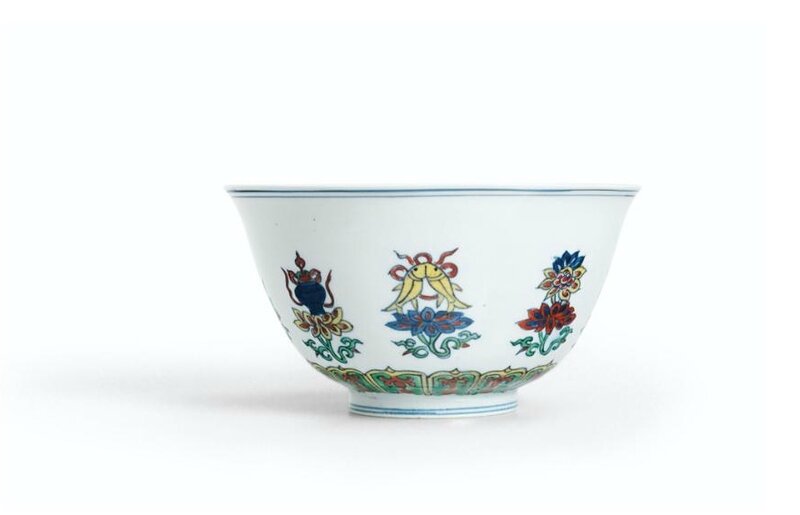A rare doucai 'Bajixiang' bowl, Mark and period of Wanli (1573-1620)
Lot 44. A rare doucai 'Bajixiang' bowl, Mark and period of Wanli (1573-1620); 16.8 cm., 6 5/8 in. Estimate 5,000,000-7,000,000 HKD. Lot sold 6,020,000 HKD. Photo Sotheby's
the exterior of the deep rounded sides painted in underglaze blue, red, green and yellow enamels with the bajixiang ('Eight Buddhist Emblems'), with the lotus flower, twin yellow fish, blue vase, yellow endless knot, polychrome wheel, white conch shell, blue umbrella, green and blue canopy, some tied with red ribbons, supported on lotus sprays, the interior painted with a lingzhi spray enclosed in a double ring in the centre, the base inscribed with a six-character reign mark within a double rectangle in underglaze blue
PROVENANCE: Collection of Sir John Braithwaite (until 1973).
Sotheby's London, 26th June 1973, lot 231.
Sotheby's Hong Kong, 29th November 1977, lot 28.
The British Rail Pension Fund (until 1989).
Sotheby's Hong Kong, 16th May 1989, lot 31.
The Tsui Museum of Art, Hong Kong.
Sotheby's London, 6th December 1995, lot 284.
Sotheby's Hong Kong, 7th October 2006, lot 925.
Eskenazi Ltd, London.
EXHIBITED: Dallas Museum of Art, on loan 1985-1988.
Joined Colours. Decoration and Meaning in Chinese Porcelain, Min Chiu Society at the Arthur M. Sackler Gallery, Smithsonian Institution, Washington, D.C., 1993, cat. no. 27.
LITERATURE: The Tsui Museum of Art, Hong Kong, 1991, pl. 87.
Sotheby's Hong Kong – Twenty Years, 1973-1993, Hong Kong, 1993, pl.128.
Sotheby's. Thirty Years in Hong Kong, Hong Kong, 2003, pl.173.
Regina Krahl, Chinese Ceramics from the Meiyintang Collection, London, 1994-2010, vol. 4, no. 1702.
NOTE: During the Wanli reign (AD 1573-1620) doucai porcelain of the Chenghua period (AD 1465-87) rose considerably in appreciation and value and the Wanli Emperor himself is said to have been particularly fond of it. The imperial kilns therefore began to make copies of Chenghua patterns. The present design is based on a Chenghua original and the square mark, which was seldom used in the Wanli period, also follows the Chenghua model. Extant Chenghua prototypes and Wanli versions are, however, equally rare and no other examples appear to be preserved outside China.
A Chenghua bowl re-assembled from sherds discovered at the waste heaps of the Ming Imperial kilns at Jingdezhen was included in the exhibition A Legacy of Chenghua: Imperial Porcelain of the Chenghua Reign Excavated from Zhushan, Jingdezhen, The Tsui Museum of Art, Hong Kong, 1993, cat. no. C123; and a Chenghua bowl of this design but lacking enamels is in the National Palace Museum, Taiwan, and was included in the exhibition Chenghua ciqi tezhan / Special Exhibition of Ch'eng-hua Porcelain Ware, 1465-1487, National Palace Museum, Taipei, 2003, cat. no. 131.
Another Wanli doucai bowl of this design and with the same mark, in the Palace Museum, Beijing, is published in The Complete Collection of Treasures of the Palace Museum. Porcelains in Polychrome and Contrasting Colours, Hong Kong, 1999, pl. 187; and one with the regular mark in a double circle, in the National Palace Museum, Taiwan, is illustrated in Minji meihin zuroku [Illustrated catalogue of important Ming porcelains], Tokyo, 1977-78, vol. III, pl. 98.
Sotheby's. The Meiyintang Collection, Part III - An Important Selection of Imperial Chinese Porcelains. Hong Kong | 04 Apr 2012, 10:15 AM

/https%3A%2F%2Fprofilepics.canalblog.com%2Fprofilepics%2F1%2F0%2F100183.jpg)
/https%3A%2F%2Fstorage.canalblog.com%2F03%2F02%2F119589%2F96711876_o.jpg)
/https%3A%2F%2Fstorage.canalblog.com%2F11%2F31%2F119589%2F94773502_o.jpg)
/https%3A%2F%2Fstorage.canalblog.com%2F20%2F83%2F119589%2F94772815_o.jpg)
/https%3A%2F%2Fstorage.canalblog.com%2F26%2F72%2F119589%2F75604929_o.jpg)
/https%3A%2F%2Fstorage.canalblog.com%2F59%2F60%2F119589%2F26458628_o.jpg)





/image%2F1371349%2F20240326%2Fob_936d86_104-1.jpg)
/image%2F1371349%2F20240326%2Fob_823710_102-1.jpg)
/image%2F1371349%2F20240326%2Fob_55a293_101-1.jpg)
/http%3A%2F%2Fstorage.canalblog.com%2F33%2F99%2F119589%2F129627838_o.jpg)